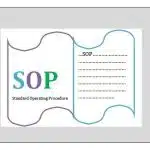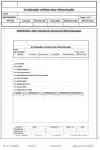Learn how to write an SOP for Maintenance of Stock Cultures in the Microbiology Laboratory of Pharmaceuticals.
Table of Contents
1.0 PURPOSE
To describe the procedure for maintaining stock cultures in a microbiological laboratory.

2.0 SCOPE
This SOP is applicable to ensure stock culture maintenance procedures for the microbiology laboratory located in Pharmaceutical.
3.0 RELATED DOCUMENTS
3.1 SOP for Preparation, Sterilization, and Preservation of Culture Media.
3.2 SOP for storage, sterilization, and disposal of biohazardous waste.
4.0 RESPONSIBILITIES
4.1 Executive, Microbiology, is responsible for maintaining stock culture.
4.2 Senior Executive/Executive, Microbiology, is responsible for supervising and maintaining stock culture procedures.
4.3 The head of Quality Assurance shall be responsible for the effective implementation and training of procedures.
5.0 ACCOUNTABILITY
Head of Department
6.0 PRECAUTIONS
Should maintain all safety safeguards in place for the microbiology lab.
7.0 PROCEDURE
7.1 Precautions
7.1.1 Maintain aseptic conditions at each step of subculturing.
7.1.2 Transfer of lyophilized microbial culture should be done properly without spillage only in the broth culture medium before transferring it to an agar slant.
7.1.3 Subculture microorganisms for routine use should always be stored in a refrigerator at 2 to 8°C.
7.1.4 Sub-culturing of each microbial culture from stock solution should not be done more than five times, and a new stock culture has to be prepared after five transfers.
7.2 Prerequisites
7.2.1 Ensure that the LAF workstation is cleaned and sanitized.
7.2.2 Prepare the media required, as per the SOP: Preparation of microbiological media.
7.2.3 Microbiologists should wear clean lab coats, caps, facemasks, and hand gloves rinsed with 70% IPA.
7.2.4 All glassware should be cleaned properly, dried, and sterilized by dry heat sterilization before proceeding to subculturing.
7.3 Procurement of Standard Cultures
7.3.1 The microbial culture should be procured from a reliable source.
7.3.2 The culture should be stored in the condition prescribed by the manufacturer.
7.3.3 The culture must not be used after the expiration date.
7.4 Preparation of culture suspension from the lyophilized culture
7.4.1 Remove the desired standard stain from the refrigerator and allow it to equilibrate to room temperature.
7.4. 2 Warm the hydration fluid and dilution fluid to 34ºC to 38ºC.
7.4.3 Pick a sterile forceps, remove two pellets, and place them into the 2.0-ml vial of hydrating fluid.
7.4.4 Immediately replace the rubber stopper, recap the vial, and return the remaining lyophilized materials to refrigerated storage.
7.4.5 Immediately recap the vial with the hydrated material and place it into a 34ºC to 38ºC incubator for 30 minutes to ensure complete hydration.
7.4.6 Immediately following incubation, vortex the hydrated material to achieve equal distribution of the challenge strain throughout the hydrated suspension.
7.4.7 Proceed to the next step immediately.
7.5 Preparation of working dilution
7.5.1 Take 1.0 cc of the thoroughly mixed moistened suspension and transfer it to a sterile pipette to 9.0 ml of pH 7 phosphate buffer and mix well.
7.5.2 This is the working culture suspension; this suspension contains 10 to 100 cfu/ml.
7.5.3 The hydrated microorganism suspension must be used within 30 minutes to ensure the microorganisms’ viability.
Related: SOP for Growth Promotion Test (GPT) of Culture Media
7.6 Preparation of stock culture and working culture
7.6.1 Transfer 50 μl of the working dilution to 50 ml of sterile broth media.
7.6.2 Incubate the broth containing the culture. The media used and the incubation conditions for different organisms are given in Annexure 1.
7.6.3 After incubation, streak a loopful of culture on an agar plate in a manner to get an isolated colony and incubate the plates.
7.6.4 After the incubation, select a colony and check the cell properties by gram staining.
7.6.5 If the organisms meet the properties of the specific organisms, pick morphologically the same one or two colonies and transfer them to a tube containing 5 ml of sterile saline solution and make a suspension. If the culture is not the specific one do steps 7.6.1 to 7.6.2 again.
7.6.6 Immerse a sterile cotton swab into the suspension and streak the agar plate uniformly to get confluent growth. Also, take a loopful suspension and streak on a tryptone soy agar slant.
7.6.7 Incubate both the plate and tube.
7.6.8 After incubation, check the growth. If significant growth is visible, tighten the cap of the tube and keep the slant in the refrigerator at a temperature of 2°C to 8°C.
7.6.9 Prepare working culture to streak a loopful culture from the stock culture to a new slant and incubate as per Annexure 1. Prepare working culture as and when required for routine use.
7.6.10 Label the slant and cryovials. The label should contain the following headings for both stock culture and working culture:
| Name of the organism | : | |
| ATCC No. | : | |
| Date of Subculture | : | |
| Next date of subculture | : | |
| Subculture by | : | |
| Checked by | : |
7.6.11 Incubate the slants at the temperature specified in Annexure 1.
7.6.12 After use or after expiry, dispose of the culture slant as per SOP.
8.0 ABBREVIATIONS
8.1 SOP: Standard Operating Procedure
8.2 ATCC: American Type Culture Collection
9.0 ANNEXURES
Annexure-1: Subculturing Frequency and Incubation Conditions for Microbial Culture.
Annexure-2:Subculture Report of Standard Microorganism Strains.


Frequently Asked Questions (FAQs)
What is ATCC cell culture?

ATCC cell culture refers to the maintenance and propagation of cells obtained from the American Type Culture Collection (ATCC), a repository of authenticated biological materials. This practice involves providing cells with suitable growth conditions to support their survival and growth for various research, medical, and industrial purposes.
Why is ATCC cell culture important?
ATCC cell culture is essential for ensuring the authenticity and quality of cells used in scientific research, drug development, and biotechnology. By using ATCC-validated cell lines, researchers can rely on consistent and accurate results in their experiments, contributing to the advancement of various fields.
How do I establish an ATCC cell culture?
To establish an ATCC cell culture, you’ll need to follow specific guidelines provided by ATCC for the particular cell line you’re working with. This generally involves thawing frozen cells, adapting them to your specific growth conditions, and regularly maintaining them by subculturing to prevent overgrowth and maintain cell health.

Abdus Sobhan Salim is professional experienced pharmacist in pharmaceuticals, author and founder of pharmabossbd.com, the first Bangladeshi pharmaceutical blogger since 2019.



